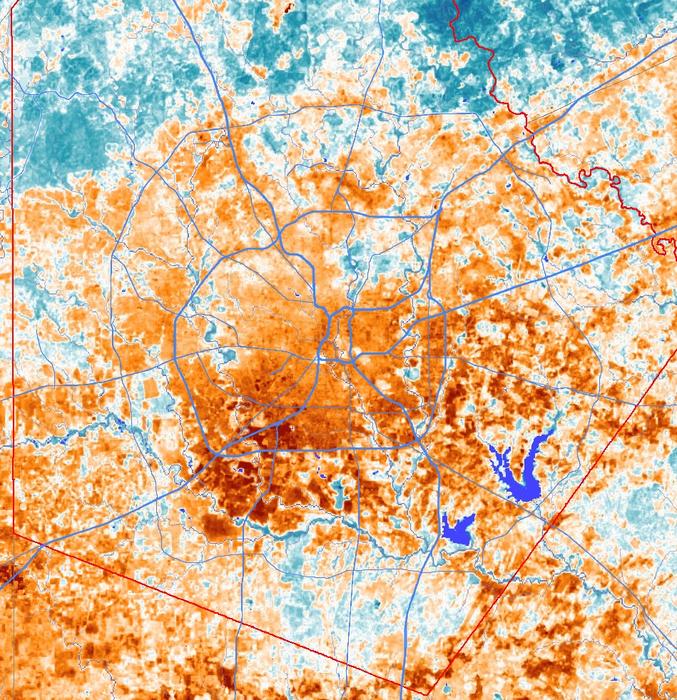SAN ANTONIO — Sept. 25, 2023 —Southwest Research Institute and The University of Texas at San Antonio (UTSA) are collaborating to study the “felt heat” of San Antonio’s historic West Side. The prevalence of paved surfaces creates an environment that feels considerably hotter than the rest of the city.
The work, led by Principal Scientist Dr. Stuart Stothoff of SwRI’s Chemistry and Chemical Engineering Division and Dr. Esteban Lopez Ochoa of the Margie and Bill Klesse College of Engineering and Integrated Design at UTSA, is supported by a $125,000 grant from the Connecting through Research Partnerships (Connect) Program.
“If you look back in time, the West Side has always been somewhat neglected,” Lopez Ochoa said. “The consideration was not there to keep green spaces, which are cooler and offer more shade than pavement, which absorbs heat. It’s just easier to pave. When you compare different areas of the city, that area does lack vegetation much more than other areas of San Antonio.”
As a result of the greater amount of paved surfaces on the West Side, people there experience considerably more heat than in the rest of the city. Recent measurements by Lopez Ochoa showed temperatures as high as 154 degrees Fahrenheit just above the pavement.
“We’re working to precisely characterize what’s going on in this unusually hot area of the city, so that eventually a solution can be found to alleviate it,” Stothoff said.
Over the next year, SwRI and UTSA will place sensors in representative locations around the West Side to measure the felt heat in various environments. The sensors will gather data on air flow, wind speeds, relative humidity, air temperatures and dew points.
“The publicly available information about the heat measured on the West Side is satellite data, derived from visible or infrared wavelengths. It’s useful, but it doesn’t characterize the actual felt heat,” Stothoff said. “Satellite data also doesn’t allow you to see underneath the trees, in the shade. By placing our sensors in various key locations, we can measure the temperatures people actually feel.”
Stothoff and Lopez are also considering putting sensors inside homes on the West Side and are working with the Historic Westside Neighborhood Association and the Esperanza Peace and Justice Center to connect with residents who might be willing to participate.
Once the data gathering is complete, SwRI will create an energy balance model to comprehensively evaluate the felt environment and adapt publicly available weather data to better represent ambient temperatures and overall thermal comfort on the West Side.
SwRI’s Executive Office and UTSA’s Office of the Vice President for Research, Economic Development, and Knowledge Enterprise sponsor the Connect program, which offers grant opportunities to enhance greater scientific collaboration between the two institutions.
For more information, visit https://www.swri.org/industries/oceans-land-climate.

Credit: Southwest Research Institute/UTSA
SAN ANTONIO — Sept. 25, 2023 —Southwest Research Institute and The University of Texas at San Antonio (UTSA) are collaborating to study the “felt heat” of San Antonio’s historic West Side. The prevalence of paved surfaces creates an environment that feels considerably hotter than the rest of the city.
The work, led by Principal Scientist Dr. Stuart Stothoff of SwRI’s Chemistry and Chemical Engineering Division and Dr. Esteban Lopez Ochoa of the Margie and Bill Klesse College of Engineering and Integrated Design at UTSA, is supported by a $125,000 grant from the Connecting through Research Partnerships (Connect) Program.
“If you look back in time, the West Side has always been somewhat neglected,” Lopez Ochoa said. “The consideration was not there to keep green spaces, which are cooler and offer more shade than pavement, which absorbs heat. It’s just easier to pave. When you compare different areas of the city, that area does lack vegetation much more than other areas of San Antonio.”
As a result of the greater amount of paved surfaces on the West Side, people there experience considerably more heat than in the rest of the city. Recent measurements by Lopez Ochoa showed temperatures as high as 154 degrees Fahrenheit just above the pavement.
“We’re working to precisely characterize what’s going on in this unusually hot area of the city, so that eventually a solution can be found to alleviate it,” Stothoff said.
Over the next year, SwRI and UTSA will place sensors in representative locations around the West Side to measure the felt heat in various environments. The sensors will gather data on air flow, wind speeds, relative humidity, air temperatures and dew points.
“The publicly available information about the heat measured on the West Side is satellite data, derived from visible or infrared wavelengths. It’s useful, but it doesn’t characterize the actual felt heat,” Stothoff said. “Satellite data also doesn’t allow you to see underneath the trees, in the shade. By placing our sensors in various key locations, we can measure the temperatures people actually feel.”
Stothoff and Lopez are also considering putting sensors inside homes on the West Side and are working with the Historic Westside Neighborhood Association and the Esperanza Peace and Justice Center to connect with residents who might be willing to participate.
Once the data gathering is complete, SwRI will create an energy balance model to comprehensively evaluate the felt environment and adapt publicly available weather data to better represent ambient temperatures and overall thermal comfort on the West Side.
SwRI’s Executive Office and UTSA’s Office of the Vice President for Research, Economic Development, and Knowledge Enterprise sponsor the Connect program, which offers grant opportunities to enhance greater scientific collaboration between the two institutions.
For more information, visit https://www.swri.org/industries/oceans-land-climate.




